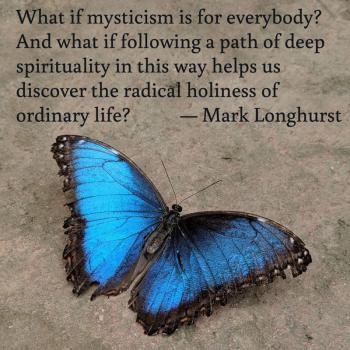Many years ago, my very first spiritual director recommended a book to me; she suggested that I read Gerald May’s 1982 classic: Will and Spirit: A Contemplative Psychology. I did, and it remains one of my favorite books on the psychology of contemplation.
Among many other treasures that I gleaned from this book, it introduced me to two Greek words that I would run into again and again during my years of exploration into mystical and contemplative spirituality. The words kataphatic (also spelled cataphatic) and apophatic might seem overly academic and jargon-y to someone who is new to contemplative spirituality, but I think they are worth getting to know, for these Greek concepts can be very helpful for learning about two very different (but complementary) approaches to prayer and meditation.
Yes, I know this might seem to be on the intellectual side, but bear with me: I’ll try to keep it as down to earth as possible.
Both apophatic and cataphatic end in “-phatic” which is the same root found in words like emphatic or prophetic. In Greek this means to speak or to say: thus, a prophet is someone who speaks for God.
Let’s look at how the prefixes kata-/cata- and apo- contrast with each other:
- Kata- is the same prefix found in words like catalogue or catechism; it is an intensifier or carries the meaning of “thoroughly” or “complete” — as in a catechism is meant to be a complete and thorough statement of doctrine.
- Apo- is the same prefix found in words like apocrypha or apocalypse; it carries the meaning of “off or away” — so, the apocrypha are “lost Biblical writings” that have been hidden (-crypha is related to crypt) off and away.
So let’s put it all together:
- Kataphatic prayer is prayer that speaks thoroughly, intensively, or positively of God: prayer that uses words, images, ideas, concepts, and the imagination to relate to God.
- Apophatic prayer is prayer that occurs without words, images, or concepts. This approach to prayer regards silence, stillness, unknowing and even darkness as doorways, rather than obstacles, to communication with God.
How They Differ From Each Other
If you’re not quite sure how to distinguish between these two types of spirituality, let me give a simple example that hopefully will illustrate the difference.
When I was a small child, I was taught to imagine God as a kindly old father-figure who lived with all the saints and angels in heaven: sort of like Gandalf from the Tolkien stories. When I prayed, I was using my imagination to talk to this kindly celestial super-dad. In other words, my first experience of prayer was kataphatic, rich with images and concepts that helped my toddler-brain make sense of the mystery we call “God.”
But then I got older. I can’t pinpoint exactly when it happened, but there came a time when I came to understand that my early childhood images were woefully incomplete when it comes to helping me to relate to God. After all, God is certainly not a human male, or an old father-figure, or even limited to human form. Christians recognize Jesus as human, but the other two “persons” of the Holy Trinity (the Christian understanding of God) simply cannot be “contained” by any image, concept, or words that anyone might use to try to describe God. So at some point in my life, my early childhood kataphatic image of God was replaced by a more abstract but no less “real” apophatic understanding that stressed God’s mystery, incomprehensibility, and transcendent otherness. It seemed that any word we might use to describe God — beginning with the word “God” itself — was destined to fail, like trying to empty the ocean with a spoon.
Putting it Into Practice
Kataphatic spirituality is the kind of spirituality that relies on images: for many children (and even adults), it’s helpful to have an image of God, whether it’s a kindly old father, a nurturing mother, or some other concept we can relate to. By contrast, apophatic spirituality, conscious of how limited and incomplete even the best images of God can be, seeks to be present to God at the level of the heart, deeper than any words, images or concepts can go.
Centering Prayer is a great example of a apophatic prayer: it emphasizes silence and stillness and seeking to let go of any thoughts, images or daydreams that might occur during our time of prayer. On the other hand, Ignatian Prayer, the imaginative type of prayer that Saint Ignatius of Loyola recommends in the Spiritual Exercises is a great example of kataphatic prayer: it is based on using your imagination to have a meaningful inner encounter with Jesus or the Spirit, using your God-given imagination as a way of praying to (communication with) God.
Apophatic prayer and kataphatic prayer are both meaningful and beautiful ways to connect with God. And even though the example from my life could give you the impression that apophatic prayer is more advanced or mature than cataphatic prayer, it’s a mistake to view these two approaches hierarchically. Each has its place.
Lectio Divina, the ancient monastic practice of reading a passage from the Bible as a springboard into meditation, prayer and contemplation, is a wonderful kind of hybrid-spiritual practice that encompasses both kataphatic and apophatic ways of prayer. Reading a Biblical passage is itself deeply kataphatic: it immerses the reader into the language and imagery of scripture. Meditating or reflecting on, and the praying in response to, the content of that scripture passage simply refines the kataphatic prayer even further. But the final movement of Lectio Divina is deeply apophatic: to lay aside all the words and concepts, and then simply rest in the loving presence of the Spirit, at a heart-level deeper than languages or images can convey or reach.
Lectio is a great example of how both kataphatic and apophatic prayer belong in the “spiritual toolbox” of every contemplative. Just like some people are visual learners and others auditory learners, naturally some people will feel more at home with image-rich prayer and others will prefer the wordless silence of contemplation. But don’t just limit your prayer practice to the type of prayer that comes more naturally. Think of prayer as a balanced diet: you need all your vitamins and nutrients, not just the ones that tasted the best to you. So as you cultivate your prayer practice, try to incorporate both types of practice. Here are some examples:
Kataphatic Practices: Reading the Bible, praying vocally/conversationally, praying the liturgy, the Rosary, praying with icons or art;
Apophatic Practices: Centering Prayer, Christian Meditation (WCCM),TM, Zen, walking the labyrinth, any prayer that centers on silence and stillness;
Hybrid: Lectio Divina.
May you find joy and nurture in a spirituality that is rich with images and beauty, but that also holds it all loosely so that God may be found deep in the mystery of wonder and unknowing.














